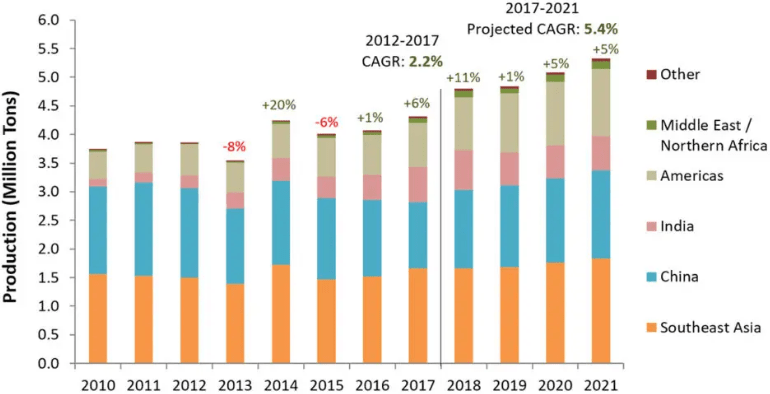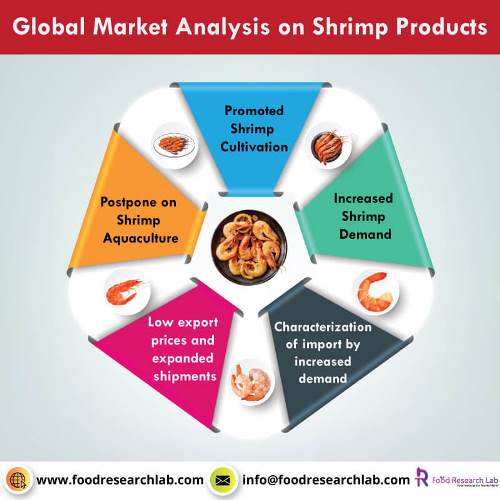Shrimp is a common seafood species that belongs to the Malacostraca, the largest class of crustaceans. Shrimp is high in omega-3 fatty acids, which help people lose weight, lower blood pressure, boost bone and brain health, alleviate eye weakness, and decrease the risk of cardiovascular disease. It also has high protein content and low-fat content. Shrimp industry waste has recently piqued interest due to the presence of valuable bioactive compounds, especially lipids, pigments, and other oligosaccharides [1]. With an annual valuation of over $57 billion, crustacean farming is one of the most important global aquacultures, accounting for roughly 23% of the entire global aquaculture industry (UN FAO Fisheries and Aquaculture Department, 2018).
Global Market Analysis on shrimp products
Shrimp is a common seafood species that belongs to the Malacostraca, the largest class of crustaceans. Shrimp is high in omega-3 fatty acids, which help people lose weight, lower blood pressure, boost bone and brain health, alleviate eye weakness, and decrease the risk of cardiovascular disease. It also has high protein content and low-fat content. Shrimp industry waste has recently piqued interest due to the presence of valuable bioactive compounds, especially lipids, pigments, and other oligosaccharides [1]. With an annual valuation of over $57 billion, crustacean farming is one of the most important global aquacultures, accounting for roughly 23% of the entire global aquaculture industry (UN FAO Fisheries and Aquaculture Department, 2018).
The Global Shrimp Market is forecast to reach US$ 24.1 billion by 2026, according to the report. Many governments are promoting shrimp cultivation by providing financial incentives and tax breaks to producers. Apart from China and Vietnam, Ecuador is the world’s largest exporter of shrimp. The United States is the main Shrimp producer among consuming countries.
In 2020, the global shrimp industry will hit 8.12 million tons. Because of rising demand, the industry is expected to expand at a CAGR of 4.5% from 2021 to 2026, reaching a capacity of 10.7 million tons by 2026.
By-products from shrimp and fortification
Various traditional and novel techniques have been used to remove shrimp oil from the cephalothorax and hepatopancreas (2) (3) (4) (5). The bread was (6) fortified with microencapsulated shrimp oil (MSO). When applied up to 3%, MSO fortification resulted in increased loaf volume and appropriate sensory content [7]. MSO was fortified in biscuits with sodium caseinate, fish gelatin, and glucose syrup (1:1:4, w/w/w) as wall materials and stored for 12 days. When MSO was applied up to 6%, the nutritional content of the biscuit was increased without a detrimental effect on sensory quality [8].
There are organizations that provides appropriate strategies for successful new product development, which aids in development and formulation of innovative food products.
Shrimp demand has increased globally
In 2020, the pandemic of COVID-19 decreased total shrimp consumption. Although retail sales of shrimp were high in both the foreign and domestic markets, the foodservice industry suffered significant losses. Recently, the mid-autumn festival in October has sparked a significant increase in China’s catering industry. This could lead to more restaurant openings in China in the coming months.

(Sources: FAO (2019) and GOAL surveys (2011 to 2018) for 2010 to 2017;
GOAL survey (2019) for 2018 to 2021).
Supply
Due to the COVID-19 outbreak, the shrimp aquaculture season in Asia has been postponed until 2020. Pond stockings were delayed in most producing countries after the early season panic harvests in April, resulting in a reduction in real farming days during the lockdown time. Shrimp farmers also introduced Medium-density aquaculture due to low ex-farm costs, which lasted until August 2020. Following sharp contractions in global demand from the foodservice market, raw materials were short-supplied in India from April to August 2020, though ex-farm prices stayed at record low levels. The supply situation in Vietnam and Indonesia was stronger. In reaction to shifts in consumer demand, export processors in those countries concentrated on value-added goods and retail packaging. In 2020, Thailand’s output was lower than in 2019, impacting raw material supplies for export manufacturing. Farmers in Thailand have been discouraged by low ex-farm prices and falling tourism. Domestic production in China also fell in 2020 as a result of shrimp disease and bad weather.
International commerce
In the international market, the industry tends to follow the shifting demand trend. During April-June 2020, the industry held some equilibrium as supply decreased, with high retail demand but large demand losses in the catering trade (70-80%). While the foodservice industry in North America and Europe improved during the summer months, most restaurants were forced to run at just 25 to 30% capacity due to the required social distancing steps. Owing to the ongoing flight bans worldwide, demand for air travel has also suffered and has yet to rebound. Despite these constraints, the global shrimp trade remained relatively stable in April-August 2020, despite reduced supplies, especially from Asia. Nonetheless, imports rose in China’s and the United States’ two biggest economies, where retail prices hit new highs from April to September 2020.
Food Research Lab helps understand food safety challenges for manufacturers and streamlines the product development process. (10)
Exports
During the first half of 2020, supplies improved from the top two exporters, Ecuador and Indonesia. Ecuador benefited from record low export prices and expanded shipments to the United States of America, while Indonesia’s processed shrimp exports increased during the review period. Other countries’ exports of processed shrimp rose as well, but not from Thailand or China. Compared to the same timeframe in 2019, cooked frozen shrimp exports increased by 35% in India and Indonesia during the study period. Argentina’s sea-caught shrimp exports fell by 16 % to 45,000 tons due to lower catches during the study period. (9)

Imports
During the period January-June 2020, China overtook the United States as the leading shrimp importer. Imports rose slightly in the United States but fell in the European Union, Japan, Canada, and many other developing markets worldwide. During this time, US imports were characterized by increased demand for processed shrimp, while raw head-on and headless shell-on shrimp remained the dominant products in China’s imports. Imports into Vietnam (for re-exports) fell to a historic low of 22,000 tons, or 75% less than in January-June 2019. This drop was caused by the Chinese government’s continued control over unreported imports from this region.
Summary
Due to the late seeding of wetlands in 2020, supplies will be limited until the end of the year, particularly in areas not impacted by winter (Indonesia, Malaysia, southern Thailand, Andhra and Tamil Nadu states in India). On the other hand, China, eastern India, Viet Nam, Thailand, Myanmar, and Bangladesh will experience a low season from November to February. The yield of farmed shrimp in Asia is expected to fall 15 to 20% in 2020 compared to 2019. The Chinese mid-autumn festival and the October National Day holiday raised shrimp demand significantly, as outdoor eating increased sharply. Since COVID-19 is still raging in the United States and Europe, many Chinese customers have chosen to fly within their own country. China’s frozen shrimp inventories have decreased, indicating that imports will increase in the coming months. Imports from the United States increased in the third quarter of the year, allowing for ample stocks for year-end use.
Meanwhile, restaurant sales are expected to decline during the winter months. In Europe and Japan, the consumption pattern will be close, with some increase in demand anticipated during the Christmas/New Year season. Ex-farm prices for Asian and Ecuadorian shrimp peaked in September 2020. Price rises are forecast due to seasonal shortages in Asia and strong demand from China before the Lunar New Year in 2021. China’s imports of Ecuadorian shrimp are expected to increase in the coming months after the country’s bans were lifted. Meanwhile, shrimp e-commerce and home delivery have generated new marketing and sales opportunities in importing and manufacturing countries. On a long-term basis, this pattern will persist.

Let’s create something Innovative and Delicious together
Food Research Lab strives for excellence in new Food, Beverage and Nutraceutical Product Research and Development by offering cutting edge scientific analysis and expertise.




